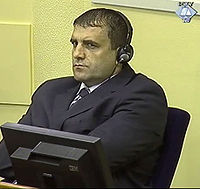Višegrad massacres
According to documents of the International Criminal Tribunal for the former Yugoslavia (ICTY), based on the victims reports, some 3,000 Bosniaks were murdered during the violence in Višegrad and its surroundings, including some 600 women and 119 children.
[6] The viciousness of the crimes of violence committed by the Army of Republika Srpska in the Višegrad massacres and the effectiveness with which the town's entire Bosniak population was either killed or deported by Republika Srpska forces in 1992, long before similar events in Srebrenica, have been described as epitomising the genocide of the Bosniak population of eastern Bosnia carried out on orders from the Bosnian Serb leader Radovan Karadžić and his military counterpart General Ratko Mladić.
Soon thereafter, local Serbs, the police and paramilitaries began one of the most notorious campaigns of ethnic cleansing in the conflict, designed to permanently rid the town of its Bosniak population.
[8] Except for an apparently small number who escaped, all of the able-bodied Bosniak men and youths of Višegrad who had not fled the town were shot or otherwise killed, according to survivors.
Army of Republika Srpska forces were also implicated in the widespread and systematic looting and destruction of Bosniak homes and villages.
Bosniak women and girls, including many not yet 14 years old, were brought to the camp by police officers and members of the paramilitary groups the White Eagles and Arkan's and Šešelj's men.
[11] According to the survivors and the report submitted to UNHCR by the Bosnian government, the Drina river was used to dump many of the bodies of the Bosniak men, women and children who were killed around the town and on the famous Mehmed Paša Sokolović Bridge, as well as the new one.
[8] Zehra Turjačanin testified in relation to this incident: 'There were many children in that house, it's so sad', the witness said adding that the youngest child there was less than one year old.
It is believed that this war crime was most probably carried out by the paramilitary group the "Avengers" led by Milan Lukić, under the control of the Army of the Republika Srpska.
Amor Mašović, Chairman of the Bosnian Institute for Missing Persons, who was in charge of forensic investigations at the lake, believed that they had all been killed in Višegrad or a few kilometres further upstream in Muhići and Kurtalići, and their bodies thrown into the Drina.
[21] Representatives of missing persons commissions from Serbia and Kosovo joined the Institute team in conducting a joint examination of an eight-kilometre stretch of the lake.
Republika Srpska police officials gave Serb paramilitary groups lists of Bosniaks who possessed firearms.
[10] The International Criminal Tribunal for the former Yugoslavia and the Court of Bosnia and Herzegovina has processed the following for war crimes in Višegrad: An account of the massacre is depicted in the journalistic comic Safe Area Goražde by Joe Sacco.
But in the spring of 1992, a hurricane of violence was unleashed by Bosnian Serbs against their Muslim neighbors in Višegrad, with similar attacks along the Drina valley and other parts of Bosnia.
Visegrad is one of hundreds of forgotten names [...] As elsewhere, the pogrom was carried out on orders from the Bosnian Serb leader Radovan Karadic and his military counterpart General Ratko Mladić, both still wanted for genocide.
[35][36]On 8 February 2008, American Congressman John Olver, called for the remembrance of genocide in Bosnia and Herzegovina and specially paid attention the war crimes in Visegrad: As we commemorate the 13th anniversary of the Srebrenica genocide, perpetrated by nationalist Serb forces predominantly against Bosniaks, Bosnian Muslims, it is time to pay tribute to the tragic episodes not only in Srebrenica, but also in other less-known places in Bosnia and Herzegovina.
In the spring of 1992, a deliberate, centrally planned, and well-organized campaign of ethnic cleansing, mass murder, rape, torture, and intimidation terrorized the civilian population throughout Bosnia and Herzegovina and took the lives of 200,000 men, women, and children.
In the end, 2 million Bosnians were displaced from their homes, and the country's rich cultural and religious heritage and monuments were deliberately destroyed.
Today, survivors are battling post-traumatic stress disorder, orphans are still searching for their parents' remains, and new mass graves continue to be discovered.
If the international community had possessed the will to protect the UN-designated "safe haven" of Srebrenica, it would have prevented the tragic outcome and thousands of innocent lives would have been with us here today.
The people of Bosnia are still trying to rebuild their country, to reform the institutions that were responsible for the genocide, and to move beyond ethnoterritorial divisions into a functional democratic state.
We must acknowledge that justice will prevail only when General Ratko Mladić and Radovan Karadžić are apprehended, and we must never forget the horrors that befell the people of Bosnia and Herzegovina.

